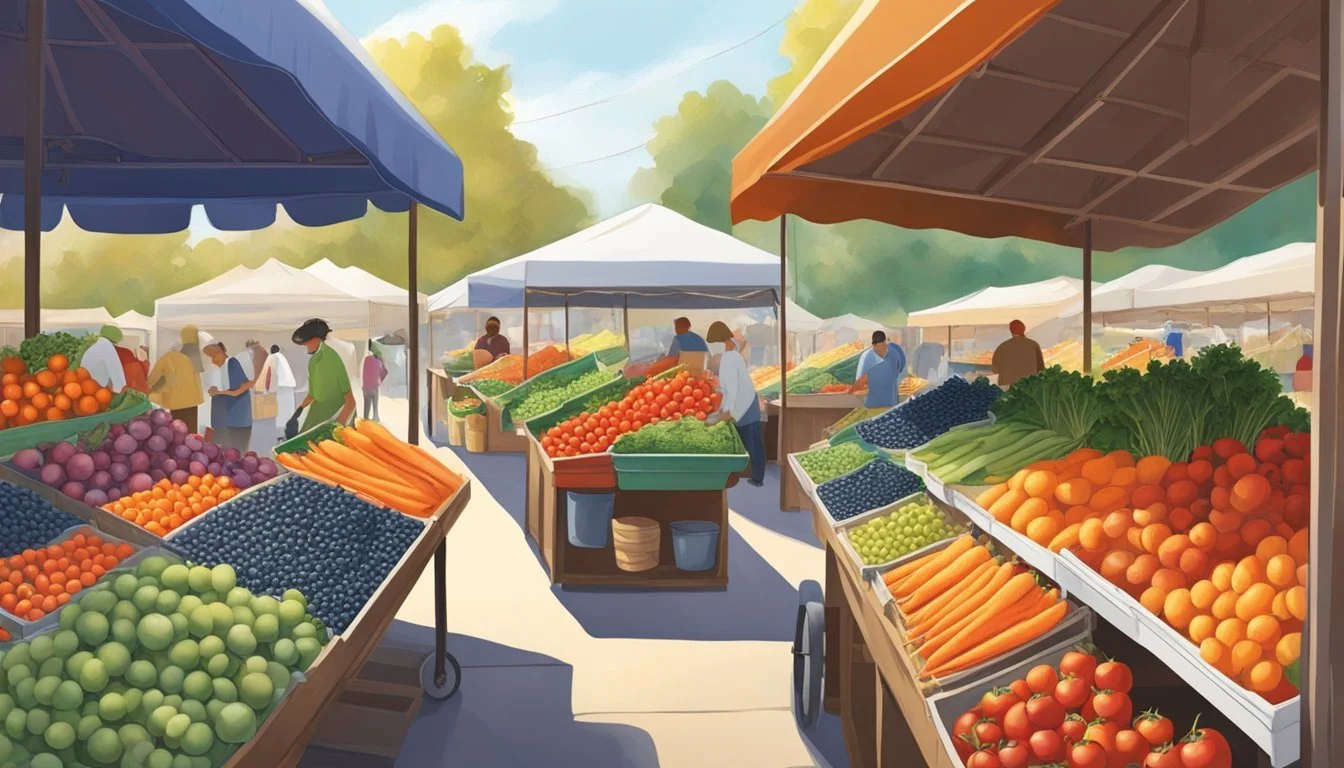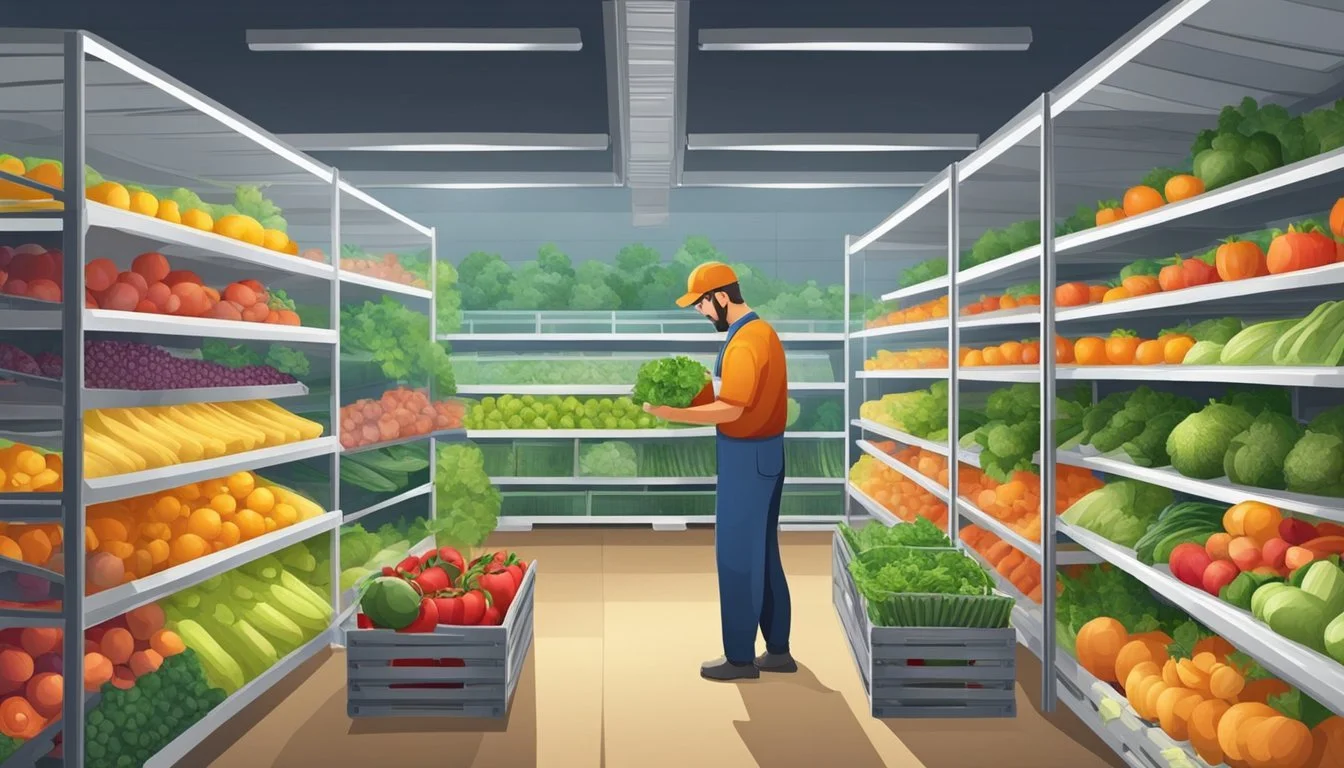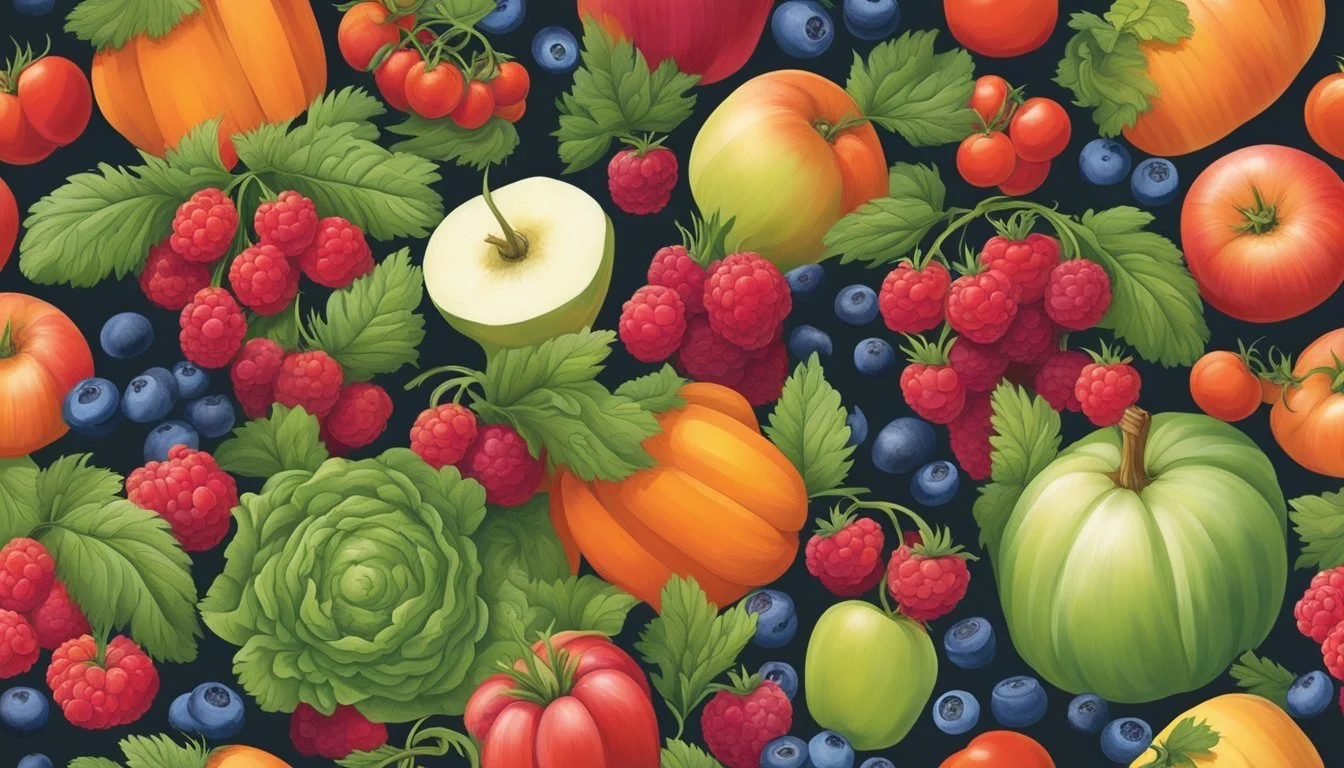Alaska Seasonal Fruit & Vegetables in September
Your Guide to Harvest Time Selections
This Article is Part of our Alaska Seasonal Fruit & Veg Calendar
September in Alaska showcases a bounty of fresh produce that reaches its peak during the late summer months. As the days begin to shorten and the cool air signals the approach of autumn, Alaskans harvest a variety of fruits and vegetables that have ripened under the long hours of summer daylight. This period provides an opportunity for both locals and visitors to experience the state's agricultural offerings at their freshest and most flavorful.
During this time, farmers' markets and local gardens overflow with produce such as greens, peas, root vegetables, and a select range of hardy fruits. The relatively cool climate of Alaska allows for certain crops to thrive, particularly those that can withstand the cooler growing conditions. Greens like lettuce and kale, as well as root vegetables like beets and carrots, are abundantly available.
Despite the state's challenging growing conditions, Alaska's unique daylight cycle during the growing season promotes the cultivation of certain fruits such as apples (how long do apples last?) and lingonberries. September is a time when these fruits, along with vegetables such as onions and potatoes, are commonly harvested, offering a snapshot into the resilience and variety of Alaskan agriculture.
Understanding Alaska's Unique Growing Season
Alaska's growing season stands distinct due to its extreme climatic conditions, which substantially affect the availability of fruits and vegetables. Two pivotal phases—summer and the transition to fall—play crucial roles in determining the produce calendar.
Climate Influence on Produce Availability
Alaska experiences a broad range of temperatures throughout the year, with a significant impact on agricultural activities. Summer months bring longer daylight hours and warmer temperatures, which are conducive to the growth of various fruits and vegetables. However, the climate is still cooler compared to many other growing regions, which affects the types of produce that can thrive. Certain hardy vegetables and berries are able to withstand the cooler summer temperatures, which are rarely excessively hot.
During the summer season, Alaska yields an array of produce including lettuce, rhubarb, and a variety of berries. The state is particularly known for its wild blueberries (how long do blueberries last?), raspberries, cranberries, and salmonberries. These fruits, cherished for their flavor, develop well in the cooler, but still hospitable, summer climate.
Transition from Summer to Fall Harvest
As the season transitions from late summer to fall, daylight diminishes and temperatures begin to drop, leading to the autumn harvest. The average first frost usually occurs in late September, marking the end of the growing season for many plants. Despite this, certain vegetables that mature quickly and can tolerate colder temperatures continue to be available.
Here are common vegetables harvested during the fall in Alaska:
Root vegetables: carrots, beets, potatoes
Cruciferous: kale, cabbage, Brussels sprouts (how long do brussels sprouts last?)
Others: zucchini, peas, broccoli
These crops have adapted to the short growing season and are typically harvested before or immediately after the first frost. The unique Alaskan climate thus necessitates careful selection of crops and precise timing for planting and harvesting to ensure a successful yield.
Alaskan Fruit Availability in September
September in Alaska marks a period of transition as the brief but bountiful growing season gives way to the onset of fall. One can find late summer fruits reaching their peak ripeness, along with early autumn tree fruits beginning to come into season.
Berries and Summer Fruits
Berries flourish in Alaska's summer climate and remain abundant in September. This month, a variety of berries are commonly at their best:
Raspberries: Recognized for their tart and slightly sweet flavor, they're perfect for eating raw or in desserts.
Blackberries: (how long do blackberries last?) Known for their dark color and juicy nature, blackberries are a favorite for jams and syrups.
Blueberries: These small, crisp berries can still be found fresh, ready to be enjoyed on their own or within baked goods.
Strawberries, which start the season earlier, are typically past their peak by this time, but some late varieties might still be harvested.
Tree Fruits Coming into Season
As the Alaskan summer progresses to fall, tree fruits notably start to appear:
Apples: Local varieties of apples become available, with characteristics that range from sweet to tart, and textures from crisp to tender.
Pears: Pears also come into season, offering a soft, juicy counterpart to the firmness of apples.
These fruits serve as indicators that the Alaskan produce season is nearing its yearly close, with each fruit offering fresh, in-season flavors unique to the region's crisp autumn.
Vegetables to Harvest in September
In Alaska, September brings a bountiful harvest. Gardeners during this time are busy collecting a diversity of vegetables whose growth cycles align with the close of Alaska's brief but intense growing season.
Root Vegetables and Tubers
Carrots: They should be firm and deeply colored. Ideal for storage, harvesting can continue until the ground freezes.
Potatoes: Look for firm tubers and harvest before the first heavy frost to prevent spoilage.
Beets: These should have a rich, vibrant color and be free of spots or deformities.
Turnips: Harvest when they are medium-sized to ensure sweetness and tenderness.
Leafy Greens and Squashes
Kale: Expected to be deep green and may be sweeter after a light frost.
Brussels Sprouts: They develop a more complex flavor post-frost.
Celery: (how long does celery last?) Should be firm and have tight stalks.
Lettuce: Harvest while leaves are tender and before the first frost.
Spinach: Pick when leaves are large enough to eat, usually before first frost.
Summer Squash: Including zucchini, should be harvested when tender and not overly large.
Pumpkins: Ready when they are bright orange and the rind is hard.
Nightshades and Cucurbits
Cucumber: Pick when they are medium-sized to keep them from becoming overly seedy.
Peppers: Harvest before the frost when they've reached desired color, either green or red.
Eggplant: These should be firm and glossy. Harvest before the first frost.
Tomatoes: Can be picked at the end of their growth cycle, before the first frost, and allowed to ripen indoors if necessary.
Post-Harvest Handling and Storage Tips
After harvesting, the goal is to maintain the freshness of Alaskan fruits and vegetables well into winter. The key to achieving this lies in understanding and applying the right storage techniques that can extend shelf life without compromising flavor.
Extending Shelf Life for Winter
To prolong the shelf life of produce for winter consumption, one should focus on:
Temperature regulation: Most fruits and vegetables fare best in cool, not freezing, environments. A fridge set to the right temperature helps keep them fresh.
Humidity control: Varying the humidity levels can be beneficial for different types of produce. Root vegetables, for instance, require higher humidity to stay crisp.
Use of airtight containers: Fruits and berries benefit from being stored in airtight containers to retain their flavor and prevent them from absorbing other odors.
Proper Storage Techniques
Proper storage involves:
Location selection: Fruits and vegetables should be stored in different areas based on their sensitivity to ethylene gas. Apples, for example, produce ethylene and can shorten the shelf life of other produce if stored together.
Physical protection: Encasing produce in paper or breathable plastic can help protect against physical damage and dehydration.
Air circulation: Good air circulation is crucial to prevent mold and spoilage. This doesn't necessarily mean leaving produce fully exposed; it can also be achieved with perforated containers.
By carefully selecting storage conditions and handling techniques, they can enjoy the freshest flavors of Alaskan produce even as the winter sets in.
Seasonal Recipes and Preparation Ideas
In September, Alaska's harvest brings a bounty of fresh produce perfect for warming dishes and sweet treats. Utilizing these ingredients, cooks can create optimal seasonal meals and preserves that give a taste of Alaska's autumn.
Cooking with Alaska's September Produce
Alaska’s September produce like apples and beets can be transformed in the kitchen to make the most of their peak flavors. Apples can be baked into cakes or sautéed with cinnamon for a classic topping on pancakes. Beets offer a vibrant color and earthy taste to salads when roasted, or they can be pickled for a tangy side dish. One might also consider blending these vegetables into smoothies for a nutritious breakfast option.
Roasted Beet Salad
Roast beets until tender
Toss with mixed greens, goat cheese, and walnuts
Drizzle with a balsamic reduction
Sautéed Apples
Core and slice apples
Sauté with butter, cinnamon, and a touch of brown sugar
Serve atop oatmeal or pancakes
Desserts and Preserves
September’s chill calls for the creation of sweet comforts. Desserts made from fresh, local fruits like apples can range from rustic apple crisps to elegant apple tarts. Preserving fruits through jams and jellies is also a splendid way to extend the enjoyment of the seasonal harvest. Berries and apples are particularly well-suited for preserves and can be used as spreads or glazes for desserts.
Apple Crisp Recipe
Mix sliced apples with sugar, lemon juice, and spices
Top with a crumble of oats, flour, butter, and sugar
Bake until golden and bubbly
Berry Jam
Simmer berries with sugar and pectin
Can while hot to seal in freshness
Use as a topping on cakes or spread on toast
Hearty Soups and Stews
The abundance of vegetables like beans and beets in September can be the foundation for nourishing soups and stews. These meals not only provide warmth but also offer a way to utilize large quantities of produce. Bean stews can be enriched with smoked meats or mushrooms while beet soups, such as borscht, are a traditional way to highlight the vegetable's deep flavors.
Bean Stew
Sauté onions, carrots, and celery
Add broth, beans, and herbs; simmer until beans are tender
Incorporate smoked sausage or mushrooms for added depth
Beet Borscht
Cook beets, carrots, and potatoes in beef or vegetable broth
Season with dill (how long does dill last?)and a spoonful of sour cream
Serve hot for a filling and nutritious meal
Closing Thoughts on Alaska's September Bounty
Alaska's agricultural calendar peaks in September, marking a period of rich harvest before the onset of winter. The emphasis on seasonal produce during this month underlines the state's unique growing conditions that favor unusually large vegetables, evidence of which is showcased at events like the Alaska State Fair.
Why September?
Optimal day length before fall equinox
Late-summer warmth concentrates sugars in fruits
Harvest occurs before the first frost
Alaska's Robust Vegetables Farmers in Alaska work tirelessly throughout the growing season, which results in an impressive September bounty. Vegetables often reach impressive sizes, as seen in local competitions. Pumpkins, for instance, can weigh hundreds of pounds, with a recorded 902-pound pumpkin highlighting the strength of Alaska's agricultural practices.
Fruits of the Land While vegetables often steal the spotlight, fruits like the Alaska Blueberry and Nagoonberry ripen to perfection, providing locals and visitors alike with a taste of Alaska's wild and cultivated landscapes.
The state boasts:
High-Nutrient Berries
Alaska Blueberry (Vaccinium alaskaense)
Nagoonberry (Rubus arcticus)
Harvest Celebrations Communities come together to celebrate their hard work and the yield of their land with events that feature the enormous produce and the culinary potential of the region’s fruits and vegetables.
The farming techniques perfected over time in Alaska couple with its unique climate to deliver a September bounty that is revered by both growers and consumers. This bountiful harvest is truly a testament to the resilience and dedication of those who cultivate this challenging yet rewarding northern landscape.








